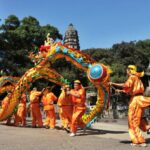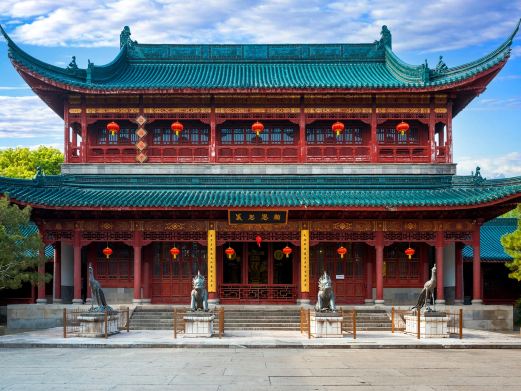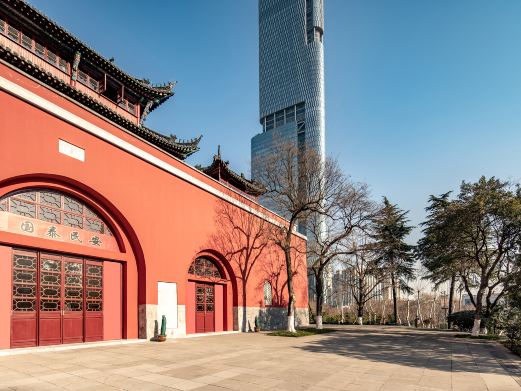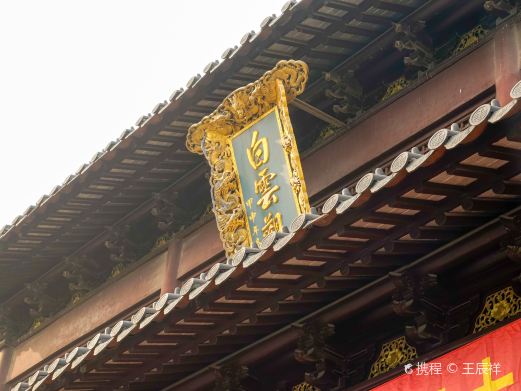Xiyuan Temple has many aliases. When you open Baidu or Google Maps, the Jiechuang Lv Temple, Xiyuan Ancient Temple, and Xiyuan all refer to Xiyuan Temple, which is the same place. The temple was built during the Zhiyuan period of the Yuan Dynasty (1264 – 1294 AD). Its original name was Guiyuan Temple. The existing buildings were rebuilt in the Qing Dynasty. During the Jiajing period of the Ming Dynasty, it was once converted into a private garden by Xu Taishi, the builder of the Lingering Garden who was an official in the Taipu Temple.
Now, as a temple garden in Suzhou City, its architectural feature of combining temples and gardens should be influenced by the Ming Dynasty. The main buildings of the temple are all on the north-south central axis. You can visit them one by one along the central axis. To the south outside the temple is a screen wall with ‘Jiechuang Lv Temple’ written on it. To the north of the screen wall are the Fude Bridge and Zhihui Bridge spanning the Shangtang River side by side. On the other side of the river is an imperial archway with ‘Imperially Bestowed Xiyuan Jiechuang Lv Temple’ written on it. The words ‘Zhenguo Jiechuang’ in the middle of the vertical plaque above the archway were bestowed by Emperor Guangxu of the Qing Dynasty. To the north of the imperial archway is the mountain gate. Entering the mountain gate means entering the temple. First, you will see a large square full of pine and cypress trees. There are many ancient trees in Xiyuan Temple. Camphor trees, ginkgo trees, etc. all have a history of more than a hundred years. Along the corridor to the north, there are bell towers and drum towers on the east and west sides of the road. After walking through the corridor, you can see the Mahavira Hall. The Sanbao Tower at the northern end is the Tripitaka Pavilion and is not open to the public. There is a Guanyin Hall on the east side of the Mahavira Hall. The Five Hundred Arhats Hall on the west side is a building worth seeing in the temple. There are five hundred gilded arhat statues from the Qing Dynasty with different shapes. After worshipping the 13-meter-tall Thousand-Handed Guanyin carved from camphor wood in the middle of the hall, the characteristic activity of ‘counting arhats’ begins. For men, start from the left; for women, start from the right. Choose one that pleases you and start counting. Count one by one until you reach your nominal age. The arhat in front of you represents your present life. Remember the serial number of the arhat and get a corresponding arhat card at the entrance of the arhats hall. There are annotated divination texts on it. There is a statue of Ji Gong on the south side of the arhats hall and a statue of a crazy monk on the north side. The clothes and folds of the two statues seem real. It is said that they are the masterpieces of two leading teachers who made the five hundred arhat statues competing with each other. Then, walking westward, the Xiyuan in the west of the temple is also a major attraction. This is a place with a strong Suzhou garden style. In the middle is a tadpole-shaped release pond with the head facing south and the tail facing north. The tail extends to the southeast, leading the pool water to circle the garden once and directly connecting to the Xiangji Pond in front of the Mahavira Hall, which is in line with the architectural feature of everywhere being waterscapes in Jiangnan gardens. In the middle of the lake is a pavilion in the middle of the lake. With the surrounding rockeries and pavilions, it doesn’t look like a temple at all. The two Ming Dynasty soft-shelled turtles that have lived for more than 400 years in the release pond have always been a topic that tourists talk about enthusiastically. Soft-shelled turtles are very precious and there are only a few in the world.It is a pity that one of them passed away in 2007. There is a bronze statue of a big turtle in the southwest corner of the release pond. Tourists who cannot see the big turtle can take a photo with the bronze statue to make up for the regret. The ‘four-sided hall’ on the east side of the release pond is the place for distributing Buddhist items. You can buy Buddhist souvenirs such as prayer beads.
There are two wisteria trees from the Ming Dynasty on the terrace of the four-sided hall, with a tree age of more than 400 years. There is even a wisteria tree with a tree age of more than 500 years on the south side. The Dharma Propagation Department on the south side of Xiyuan can receive free Buddhist scripture booklets. Xiyuan Temple is a temple in Suzhou that is widely known among the local people for being very effective in making wishes. You can pray for blessings here. On the first and fifteenth day of each lunar month, there are continuous pilgrims. During the Spring Festival, the incense is particularly prosperous. On the first day of the lunar new year, many pilgrims come to burn incense. On the birthdays and commemorative days of various Bodhisattvas, the temple will also hold Dharma assemblies. There is a vegetarian restaurant inside the temple, on the west side of the Heavenly King Hall and on the south side of the Hall of Five Hundred Arhats. There are only three kinds of noodles, Ruyi Noodles, Arhat Vegetarian Noodles, and Guanyin Noodles. The per capita cost is only 10 yuan. Outside the temple, there is Gongdelin, a vegetarian restaurant with a long history. The price is slightly higher than that inside the temple. The vegetarian chicken and ‘sweet and sour pork ribs’ are very delicious. To the west of Xiyuan Temple is Hanshan Temple. To the east is Lingering Garden. To the north are Dingyuan Garden and Tiger Hill. You can arrange your tour route according to your own preferences. Opening hours: Open all year round from 07:30 to 18:00. Preferential policies: Children: Children under 6 years old (including 6 years old) or children with a height of 1.4 meters (including 1.4 meters) or less can enter for free with valid identification documents. Free. Children, students, and the elderly: Minors aged 6 (excluding 6 years old) to 18 (including 18 years old), full-time undergraduate and below students, and the elderly aged 60 (including 60 years old) to 70 (excluding 70 years old) can enjoy half-price tickets with valid identification documents (please purchase discounted tickets at the scenic spot on your own). Half price. The elderly: The elderly aged 70 (including 70 years old) or above can enter for free with valid identification documents. Free. Military personnel: Active-duty soldiers of the People’s Republic of China and retired military cadres can enter for free with valid identification documents. Free. Disabled people: Disabled people and one accompanying person of severely disabled people can enter for free with valid identification documents. Free. Supplementary note: The above information is for reference only. The specific information is subject to the publicity of the scenic spot.









